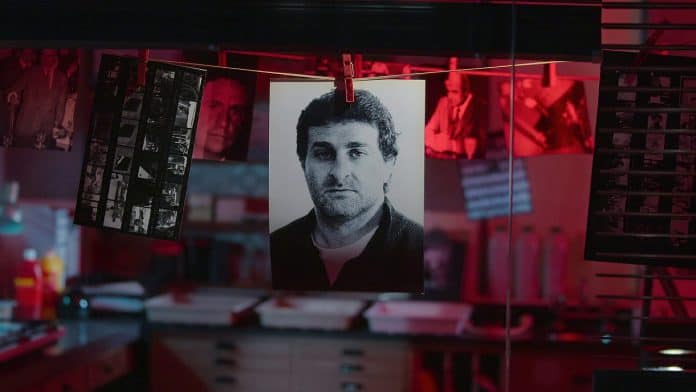The Photographer: Murder in Pinamar (2022) is a documentary that sheds new light on the murder of photojournalist José Luis Cabezas. It was a crime that led thousands to the streets to demand justice. The film is currently streaming on Netflix.
Warning: This article contains heavy spoilers.
The mystery of Cabezas’s murder
A crime that rocked Argentina and with it, brought about a wave of change. It was the murder of a prominent journalist, José Luis Cabezas, working for a well-known magazine called Noticias.
‘The Photographer: Murder in Pinamar’ explores the motives behind Cabezas’s death, the controversial investigation into the case, political conspiracies, and the broader context of political corruption at the time of his homicide.
On January 25, 1997, a burning car was discovered by authorities. Inside the car, José Luis Cabezas was handcuffed to the steering wheel and burnt beyond recognition.
Corruption and power
As Cabezas’s family and colleagues strived for justice, it soon became apparent that the case went all the way up the chain of command, with corrupt politicians, police officers and more involved in the case.
While there was a resolution to this case, it also served to underline the problems that the nation was still grappling with in the wake of such a shocking murder.
Cabezas had sneaked a photograph of Yabrán and his wife and posted it as a cover of Noticias magazine, knowing that he was notoriously private about his life and his whereabouts. It later leads to the conclusion that Yabrán and the police were involved in the murder as the investigation was slow-paced and seemed intentionally clumsy.
Evidence and premise of the murder
Noticias was a leading local Spanish news magazine published weekly and was well known for its investigative journalism, often exposing corrupt individuals in the public sphere.
On January 25, 1997, Cabezas was kidnapped and set on fire by a gang of men.
Cabezas was kidnapped in Pinamar in the early hours of January 25, 1997, as he headed home from a celebration. He was crushed, tortured and shot twice.
His body was then placed inside a vehicle owned by Noticias, and burnt. He was 35 years old at the time of his death.
Just days before he was killed, Cabezas had been engaged on a narrative about Yabrán with his colleague, Gabriel Michi, and had been trying to arrange an interview. It was established early on that Yabrán was unhappy with their reporting.
Cabezas’s killing led to mass protests in Argentina, particularly, by the media industry, journalists, human rights groups and Cabezas’s supporters who saw death as an attack on independent journalism. Many were also frustrated that justice had not been served for Cabezas’s death.
Suspects
Almost a year earlier, on February 16, 1996, Cabezas had taken a photograph of Alfredo Yabrán and his wife in Pinamar, a resort city on the coast of the Atlantic Ocean that was once visited by wealthy business people, actors, celebrities and politicians.
Yabrán was a prominent Argentinian businessman with alleged links to the government. He was notoriously private and did not allow for his photograph to be taken.
Cabezas’s image of Yabrán, wearing white checked swimming shorts while walking along the beach with his wife, in a black swimsuit, was published on the cover of Noticias in March 1996, exposing Yabrán’s identity to the public for the first time.
According to various speculations, as shown in The Photographer: Murder in Pinamar, Yabrán ordered Cabezas’s killing in retaliation for taking the photograph.
Investigation and arrests
An investigation was eventually launched and several men were arrested, but the general public saw it as a cover-up by Buenos Aires Province Governor Eduardo Duhalde.
It was later revealed that police officers Gustavo Prellezo, Sergio Cammarata and Aníbal Luna had been watching Cabezas. Yabrán’s wife had requested intel on Cabezas just two weeks before he was killed.
In February 2000, eight members of a gang called ‘Los Horneros’, consisting of some police officers and security officials, were sentenced to life imprisonment. They have since all been released or died in custody.
Only one member of the gang, Miguel Retana, confessed to being a part of Cabezas’s assassination. He also accused former Buenos Aires police officer, Gustavo Prezzello of being the group’s leader and Cabezas’s killer.
The two other police officers sentenced for Cabezas’ killing were Sergio Camaratta and Anibal Luna. Yabrán’s security chief, Gregorio Ríos, was also convicted.
According to the Committee to Protect Journalists, the mastermind of the killing was Yabrán himself, who took his own life in 1998, one year after Cabezas’ death. The men convicted of Cabezas’s murder were as follows: Gustavo Prellezo, Miguel Retana, Sergio Aníbal Camaratta, Aníbal Luna, Gregorio Ríos, José Luis Auge, Sergio Gustavo González, Horacio Anselmo Braga and Alberto Gómez.
Also Read: Brotherhood season 2 summary and ending explained

